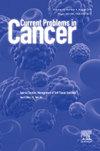患者报告了接受放射治疗的乳腺癌患者的症状毒性结果
IF 2.3
4区 医学
Q3 ONCOLOGY
引用次数: 0
摘要
背景:与医生报告的结果(PhyRO)相比,患者报告的结果(PRO)通常报告的症状毒性更大。在本研究中,我们测量了乳腺癌辅助放疗患者的症状毒性PRO,并与PhyRO进行了比较。我们分析了导致PRO症状严重程度加重的因素。我们还评估了与健康相关的生活质量(QoL)。材料与方法前瞻性纳入67例接受辅助放疗的乳腺癌患者。PhyRO报告使用CTCAE v5.0, PRO报告使用PRO CTCAE v1.0。为了确定PRO和PhyRO之间的一致程度,我们采用加权Kappa统计。采用eq - 5d - 5l量表评定生活质量。结果放疗后,将PRO与PhyRO进行比较,在恶心、呕吐、吞咽困难、吞咽困难、厌食、疲劳等症状上具有相当的一致性(K = 0.21 ~ 0.40);疼痛的一致性中等(K = 0.41-0.60);在肌痛方面有轻微的一致性(K = 0.01 ~ 0.20);瘙痒的诊断结果几乎完全一致(K = 0.81-1.00),皮炎的诊断结果基本一致(K = 0.61-0.80)。总体而言,PhyRO和PRO之间的一致性较差。患者年龄(41-60岁)、文化程度、家庭主妇、已婚女性、农村背景、经济状况不佳、II期、三场治疗、低分割治疗和医生的男性是与PhyRO症状毒性较小显著相关的因素。根据PhyRO和PRO报告的毒性严重程度,患者的平均效用值没有差异。结论:本研究强烈支持将PRO纳入常规临床护理,作为对PhyRO的补充信息,以改善患者护理,依从性和临床结果。本文章由计算机程序翻译,如有差异,请以英文原文为准。
Patient reported outcomes for symptom toxicity in breast cancer patients undergoing radiotherapy
Background
Patient reported outcomes (PRO) usually report greater symptom toxicity compared to physician reported outcomes (PhyRO). In the present study, we measured PRO about symptom toxicity in breast cancer patients undergoing adjuvant radiotherapy and compared them with the PhyRO. We analysed the factors responsible for greater symptom severity on PRO. We also assessed the health-related Quality of Life (QoL).
Materials and methods
Sixty-seven breast cancer patients undergoing adjuvant radiotherapy were prospectively enrolled. PhyRO were reported using the CTCAE v5.0 while PRO were reported using PRO CTCAE v1.0. To determine the level of agreement between the PRO and PhyRO, we employed weighted Kappa statistics. EQ-5D-5 L scale was used to assess the QoL.
Results
Post radiotherapy, when PRO were compared with PhyRO, fair agreement (K = 0.21–0.40) was seen for nausea, vomiting, dysphagia, dysgeusia, anorexia and fatigue; moderate agreement (K = 0.41–0.60) was seen for pain; slight agreement (K = 0.01–0.20) was seen for myalgia; almost perfect agreement (K = 0.81–1.00) was seen for pruritis and substantial agreement (K = 0.61–0.80) was seen for dermatitis. Overall, the concordance between PhyRO and PRO appeared poor. Factors which were significantly associated with lesser symptom toxicity on PhyRO were patient age (41-60 years), literacy, housewives, married females, rural background, poor financial status, stage II, treated with three fields, treated with hypofractionation and male gender of the physician. There was no difference in the mean utility values of patients corresponding to the severity of toxicities reported by PhyRO or PRO.
Conclusion
This study strongly supports the inclusion of PRO in routine clinical care as complimentary information to PhyRO to improve patient care, compliance and clinical outcomes.
求助全文
通过发布文献求助,成功后即可免费获取论文全文。
去求助
来源期刊

Current Problems in Cancer
医学-肿瘤学
CiteScore
5.10
自引率
0.00%
发文量
71
审稿时长
15 days
期刊介绍:
Current Problems in Cancer seeks to promote and disseminate innovative, transformative, and impactful data on patient-oriented cancer research and clinical care. Specifically, the journal''s scope is focused on reporting the results of well-designed cancer studies that influence/alter practice or identify new directions in clinical cancer research. These studies can include novel therapeutic approaches, new strategies for early diagnosis, cancer clinical trials, and supportive care, among others. Papers that focus solely on laboratory-based or basic science research are discouraged. The journal''s format also allows, on occasion, for a multi-faceted overview of a single topic via a curated selection of review articles, while also offering articles that present dynamic material that influences the oncology field.
 求助内容:
求助内容: 应助结果提醒方式:
应助结果提醒方式:


